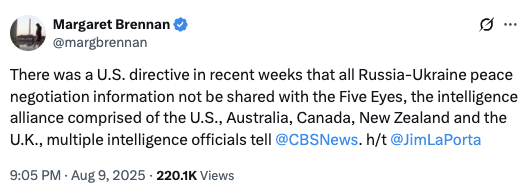
Posted August 11, 2025
By Sean Ring
Five Eyes Gets A Middle Finger
You knew the intelligence sharing protocol known as °Five Eyes” was on thin ice when then-Senator JD Vance described the UK as the world’s first “Islamist country” with nuclear weapons.
I, myself, took a load of blowback from Daily Reckoning readers when I wrote this about the UK, Canada, Australia, and New Zealand:
Stay Unique, America
I can’t describe what attending dinner parties in London during Dubya’s presidency was like. Europeans, Brits, Aussies, Kiwis, and Canadians just don’t think like Americans.
Tell just one of these folks you think you should have the right to defend yourself with a gun. They’ll look at you like you’ve grown an additional head. Tell them taxes are too high, or you don’t like paying them whatever level they are. “You don’t want to pay your fair share!” they’ll scream as they fail to define a fair share.
Nowadays, tell them a biological man taking estrogen shots shouldn’t compete in women’s sports. “Bigot!” they’ll scream.
America needs to stay America. Uniting with “the other white people” will only dilute American values. It’s the last thing the world needs.
And quite frankly, taking territory off your allies is going to make China, Russia, and BRICS look like attractive options.
So you can imagine how raised my eyebrows were when I saw this tweet:

Credit: @margbrennan
Now, JD Vance wouldn’t care much, but when Margaret Brennan tweets, The Swamp listens. And her latest revelation? The USG has quietly told its closest intelligence allies, Five Eyes, to remain in the shadows and not to interfi.
For the uninitiated, Five Eyes isn’t a spy novel code name. It’s the real-world, post-WWII intelligence-sharing pact between the United States, the United Kingdom, Canada, Australia, and New Zealand. Born from the 1946 UKUSA Agreement, this alliance became the most tightly knit signals-intelligence-sharing club in the world. Think NSA and GCHQ swapping intercepted calls like baseball cards, except the stakes are nuclear war, terrorism, and global espionage.
For decades, the Five Eyes arrangement was the gold standard for allied trust. Information flowed so freely among these countries that many analysts described the system as “one intelligence service with five branches.” When a terror plot was uncovered in Sydney, Ottawa could know about it within hours. If a rogue state tested a missile, Wellington and London got the raw intercepts, not a sanitized press release.
That’s why Brennan’s tweet is such a bombshell. For the U.S. to put up a firewall—specifically around intel on Russia-Ukraine peace talks—signals a profound shift. By default, everything in the Five Eyes world is shared unless there’s a compelling reason not to. And in intelligence circles, “we’re keeping this to ourselves” is rarely a casual decision.
Why This Matters
Restricting access to such a high-profile, high-stakes subject undermines the assumption of total transparency among the Five Eyes partners. If Washington can wall off Ukraine negotiations today, it could do the same tomorrow for Taiwan, Iran, or anything else it deems too politically delicate. And quite frankly, it should. The UK has been visibly opposed to Putin for so long.
Intelligence is like a jigsaw puzzle: no one country sees the whole picture. By withholding pieces, the U.S. risks its allies acting on incomplete or outdated information, which is dangerous when dealing with nuclear-armed states and global conflicts.
Past withholdings in the history of Five Eyes have usually been about protecting sources or methods. This feels different—more like the White House wanting to keep a tight lid on diplomatic optics, especially if the negotiations include concessions or off-the-record understandings.
The Historical Context
The Five Eyes emerged from the ashes of World War II when the U.S. and UK formalized their signals intelligence collaboration. Over time, Canada, Australia, and New Zealand joined, creating an Anglosphere spy superstructure. The alliance became the hidden scaffolding of the West’s Cold War strategy—tracking Soviet submarines, intercepting Warsaw Pact communications, and sharing cryptanalysis breakthroughs.
In the Post-9/11 world, the Five Eyes still pays a critical role in counterterrorism, with operations so integrated that some analysts from one country were embedded inside another’s agencies. But the past decade has seen strain:
- The Snowden leaks in 2013 exposed the depth of surveillance programs, causing political backlash.
- Trump’s first term brought tensions over the politicization of intelligence.
- Disputes over Huawei, China policy, and Middle East strategy have periodically ruffled feathers.
Still, until now, the fundamental principle remained intact: the core secrets are shared.
Why Brennan’s Tweet Feels Like a Red Alert
When Washington starts treating its closest partners like distant cousins, it’s not just a diplomatic snub—it’s a strategic recalibration. U.S. policymakers might believe keeping Ukraine peace talk intel in-house prevents leaks or public backlash. But to allies, this could look like a breach of the “we’re in this together” covenant.
And the irony? If the Five Eyes start doubting each other, it’s Moscow and Beijing that stand to gain the most. Divisions inside the West’s intelligence bloc are the stuff of Russian and Chinese long-game dreams.
But this isn’t the first rift between friends.
The U.S. withheld operational intelligence from the UK and France during the Suez Crisis in 1956, partly to signal disapproval of their military intervention in Egypt. This was a cold reminder that even close allies can get iced out when political objectives diverge.
In 1985, when New Zealand banned U.S. nuclear-powered or nuclear-armed ships from its ports, Washington downgraded intelligence cooperation. Although NZ remained in Five Eyes, the U.S. restricted specific classified streams for years, only gradually restoring full access in the 2000s.
During the Snowden Fallout of 2013–2015, Snowden’s leaks embarrassed all Five Eyes members, they also triggered quiet cutbacks in how much raw intelligence was shared—especially sensitive U.S. cyber operations—until security procedures were tightened.
What This Means for Investors and Markets
From an investment perspective, this is not just spy-world gossip—it’s a geopolitical risk flare. Intelligence coordination directly affects how quickly allies can respond to crises. A weakened Five Eyes means:
- Slower Crisis Response: If allied governments get delayed or incomplete intel, their reactions to geopolitical flashpoints could be clumsy, creating more uncertainty in markets.
- More Room for Surprise Events: Traders and corporate risk officers rely on stability in the geopolitical intelligence pipeline. Breakdowns increase the odds of sudden market shocks.
- Shifting Energy & Defense Plays: Russia-Ukraine peace talks (and how they break down) directly influence oil, gas, and defense sector valuations. Investors need to consider whether reduced intel sharing means more prolonged or unpredictable conflict.
- Currency and Bond Risk: If allies see the U.S. as withholding strategic info, it can weaken the perception of coordinated Western policy, affecting FX stability, especially in GBP, CAD, AUD, and NZD.
Wrap Up
The bottom line? Intelligence-sharing disputes rarely make the headlines for long, but they can signal deep fractures in the Western alliance structure. And those fractures, if they widen, will hit defense planning, energy policy, and the global economic outlook—meaning they will hit portfolios.

Oil Off The Boil
Posted December 24, 2025
By Sean Ring

Gold Bars, Up Bars, and FUBAR
Posted December 23, 2025
By Sean Ring

EX-SQUEEZE ME!
Posted December 22, 2025
By Sean Ring

Swamp, Brains, and the Game
Posted December 19, 2025
By Sean Ring

WTI…WTF?
Posted December 18, 2025
By Sean Ring

